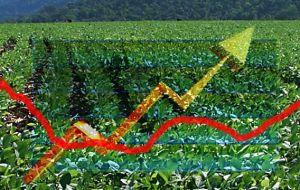MercoPress. South Atlantic News Agency
Mercosur farmers plan to sow record soybean area; stocks drop to half from a year ago
 Soybean prices have soared 19% in Chicago in the last twelve months
Soybean prices have soared 19% in Chicago in the last twelve months Mercosur farmers in Brazil and Argentina are forecast to plant more soybeans for harvesting this season in response to higher prices, at the expense of wheat and corn sowing, according to Oil World. Paraguay and Uruguay Agriculture ministries have also anticipated an increase in the soybeans planted areas.
Oilseed planting in Brazil will climb to a record 28.6 million hectares from 27 million hectares in 2011-12, the Hamburg-based researcher wrote in an e-mailed report wired on Tuesday.
Soybean prices have risen 19% in Chicago in the past 12 months, while corn prices advanced 11%. Brazil will overtake the US as the world’s largest soybean exporter in 2012-13, the US Department of Agriculture forecasts.
“Brazilian farmers have already been active sellers of new-crop soybean supplies to take advantage of the current favourable prices,” Oil World wrote. “In the domestic market soybean prices have been much more attractive for farmers than corn owing to the ample domestic corn supplies.”
Brazil’s soybean area for harvesting in 2013 is forecast to climb to 26.8 million hectares from 25 million hectares, while the corn area is seen slipping to 14.7 million hectares from 15.1 million hectares.
An estimated 37% to 40% of next year’s Brazilian soybean crop has been sold, compared with 12% normally sold at this time of year, Oil World said.
Farmers in Argentina are predicted to sow 23.5 million hectares of oilseeds, from 21.7 million hectares in 2011-12. The soybean area is expected to climb to 20.1 million hectares from 18.7 million hectares and sunflowers will cover 2.1 million hectares from 1.85 million hectares, Oil World wrote.
Argentina’s corn area is predicted to be 4.4 million hectares from 5.03 million in the previous season and wheat is forecast to be planted on 3.6 million hectares from 4.63 million hectares.
In Paraguay according to private and government estimates the current soy area of 2.9 million hectares will increase between 5% and 7%, while in Uruguay, Mercosur smallest member, the 950.000 hectares of the last season are expected to reach 1.1 million hectares for the 2012/1300.00 crop, marking a new record. The last harvest which was saved by late rains reached 2.6 million tons.
Regarding soy stocks in Mercosur countries, they have dropped by about a third against this time in 2011 after poor harvests and brisk exports.
“At the beginning of August, combined soybean stocks in Argentina, Brazil, Paraguay and Uruguay had plummeted to only an estimated 45.4 million tons, a staggering 22.5 million tons or one-third below a year earlier” Oil World said.
“Soybean crushers are reportedly facing increasing difficulties in acquiring beans considering that a large portion of the physically available stocks is already committed.”
The US is the world's largest soybean exporter, followed in second place by Brazil, Argentina and Paraguay. Drought cut soy harvests in Mercosur countries this year while another drought and heat wave is also threatening the US crop. Oil World estimates Brazil's August 1 soy stocks fell to 20.80 million tons from 33.15 million tons on August 1, 2011. It believes Argentina's stocks fell to 22.66 million tons from 30.62 million tons and Paraguay's to 1.75 million tons from 3.88 million tons.
Brazil meantime has been importing soybeans from neighbouring countries to satisfy local crushers demand.
“An estimated 0.2 million tons was apparently purchased from Bolivia, but we consider it unlikely that any noticeable quantity will be imported from Argentina and/or Paraguay where soybean supplies are currently unusually tight too” said Oil World.
Brazilian and Argentine soy exports were above expectations in June and July but they will have to drop in the remaining months of the year as supplies dwindle.
The “prospective sharp decline in Mercosur exports is boosting foreign demand for US origin to levels the United States is unlikely to satisfy, owing to the recent significant soybean crop deterioration,” Oil World added. This is a major reason why soybean prices reached all-time highs in July and kept climbing in August.





Top Comments
Disclaimer & comment rules-

-

Read all commentsThis is how business is done in Argentina!.......Long live the crushing burocracy and bribery system!
Aug 16th, 2012 - 05:27 am 0http://www.youtube.com/watch?v=-dOqouGS0xQ
Great =) Always nice to see Mercosur moving forward =) (Talking about the article not the rubbish posted by “Kretina” the cretin)
Aug 16th, 2012 - 09:21 am 0Commenting for this story is now closed.
If you have a Facebook account, become a fan and comment on our Facebook Page!